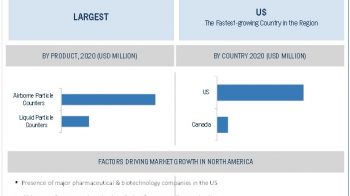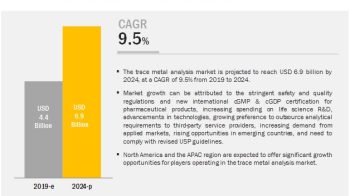Data Triangulation:
After arriving at the overall market size using the market size estimation processes as explained above the market was split into several segments and subsegments. In order to complete the overall market engineering process and arrive at the exact statistics of each market segment and subsegment, the data triangulation and market breakdown procedures were employed, wherever applicable. The data was triangulated by studying various factors and trends from both, the demand and supply sides, in the environmental testing equipment industry.
Market Size Estimation:
Both top-down and bottom-up approaches were used to estimate and validate the total size of the environmental testing equipment market. These methods were also used extensively to estimate the size of various subsegments in the market. The research methodology used to estimate the market size includes the following:
# The key players in the industry and markets have been identified through extensive secondary research
# The industry’s supply chain and market size, in terms of value, have been determined through primary and secondary research processes
# All percentage shares, splits, and breakdowns have been determined using secondary sources and verified through primary sources
Download PDF Brochure@
https://www.marketsandmarkets.com/pdfdownloadNew.asp?id=149706080
Recent Developments:
# In March 2018, Agilent established a new logistics hub in Shanghai to enable rapid delivery of the company’s instrument parts, supplies, and consumables to laboratories in China.
# In August 2016, Shimadzu acquired SINC (SINC do Brasil Instrumentaçâo Cientifica Ltda.) to strengthen its analytical and measuring instruments business in Brazil.
Overview of This Study:
The study involved four major activities to estimate the current market size for environmental testing equipment. Exhaustive secondary research was done to collect information on the market and its different subsegments. The next step was to validate these findings, assumptions, and sizing with industry experts across value chain through primary research. Both top-down and bottom-up approaches were employed to estimate the complete market size. Thereafter market breakdown and data triangulation was used to estimate the market size of segments and subsegments
Key questions addressed by the report:
# Which of the product segment will dominate the global market in the next five years?
# Emerging countries have immense opportunities for the growth and adoption of environmental testing equipment, will this scenario continue in the next five years?
# Increasing environmental awareness in the emerging market is impacting the growth for developed markets. How will the pricing difference impact the overall market?
# What are the upcoming technologies in the global market?
Request Sample Pages@
https://www.marketsandmarkets.com/requestsampleNew.asp?id=149706080
Air testing applications are expected to grow at the highest CAGR in the global environmental testing equipment market during the forecast period
On the basis of application, the market is segmented into water testing, air testing, and soil testing. The water testing segment commanded the largest share of the market in 2018. However, the air testing market is projected to register the highest CAGR owing to the increasing fatalities caused by severe air pollution levels. Increasing fatalities caused by severe air pollution levels is a major factor driving growth in the application segment.
North America is expected to dominate the environmental testing equipment market during the forecast period
Geographically, North America is expected to dominate the global environmental testing equipment market in 2018, while the Asia Pacific region is expected to register the highest CAGR during the forecast period. The high growth in this region can be attributed to the rising outdoor air pollution levels, the availability of government funding, and stringent environmental monitoring regulations.

